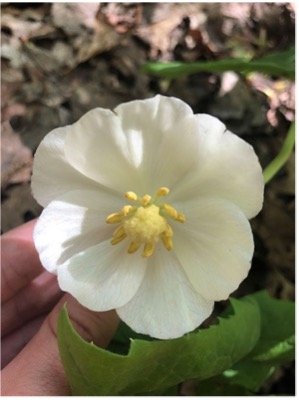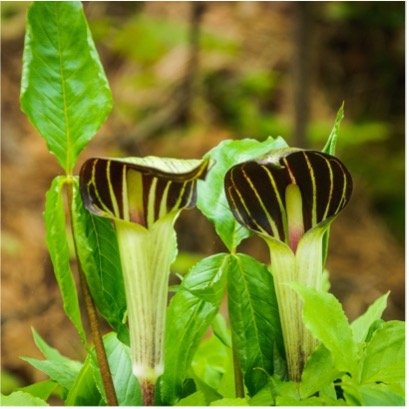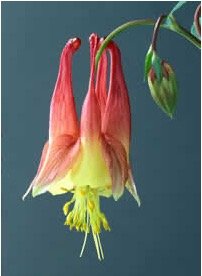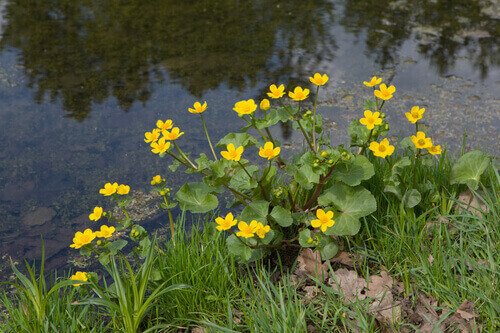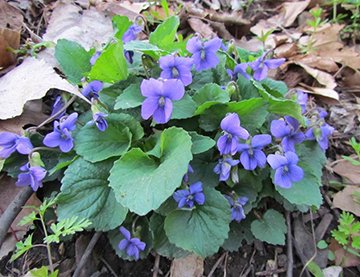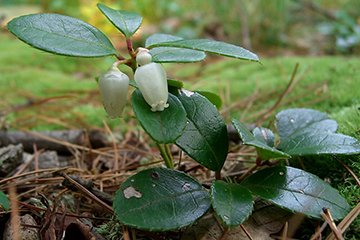Spring’s Early Gift: Ephemeral Wildflowers!
Ephemeral may mean fleeting or short-lived, but when it comes to woodland wildflowers, it really should mean magical!
As the earth warms, tiny stems of spring ephemerals peek through the leaf litter, growing into gorgeous delicate blossoms that are gone in a blink. By the time the tree canopy above fills with leaves, these native perennials have already produced flowers, dropped their seeds, then died back to spend the rest of their life cycles underground. So be on the lookout as frosty temps rise!
Here are a few fun facts about these wondrous treasures:
Unlike other flowers whose seeds are dispersed by birds, animals or wind, spring ephemeral seeds are spread by ANTS in a process called myrmecochory. To entice ants, the plants create tiny oily packets around the seeds (called eliasoems). The ants bring these oily packets to feed their larvae and the seeds wind up in the colony’s compost (poop) piles. So this means the seeds are carried only a short distance from the parent plant, making it even more important to stay on trails and not destroy any small plants.
Woodland wildflowers can take up to seven years before they bloom, and many blossom just a short time, some only a day.
Their above-ground period is called the epigeous time. Their underground period is called the hypogeous time.
Most woodland ephemerals are tiny and unique. Spring Beauties, for instance, are not much larger than a fingernail and boast lovely pink stripes on a pale background. Trout lily flowers are golden yellow with leaves speckled in spots like the fish for which they’re named.
Many wildflowers, even those edible by humans, are poisonous to dogs and cats, so be careful with pets!
We’re truly blessed because these special wildflowers are only found on three continents: North America, Japan and Russia.
Note: Even if “edible,” you should never eat a plant from the wild unless you confirm its identification through at least two trusted sources. Additionally, the “medicinal uses” are informational only, many from Native American lore, and should never be followed without consulting a health care professional.
Red Trilliums (Stinking Benjamin, Birthroot)
Usually found near mountain laurel and rhododendron, these tai-petaled flowers smell like a wet dog and the sessile emits a raw beef scent that many animals love. But, but like many wildflowers, the leaves are toxic to pups. Edible: The young unfolding leaves are an excellent addition to salads, tasting like sunflower seeds. Leaves can also be cooked as a potherb like spinach or kale. Medicinal: Used for menstrual cramps, birthing, diarrhea, respiratory distress, inflammation and bruising.
Bloodroot
Only blooming for a day or two, the solitary flowers have 8-12 petals growing on stems that rise above the foliage. They are named for their bright red sap and rhizome (root), used for face paint by Native Americans. Medicinal: It was a traditional Native American remedy for fevers and rheumatism, inducing vomiting, and for divination. During the mid-1800s, extracts were applied to the skin as part of the Fell Technique for treating breast tumors. In modern herbalism, it’s chiefly used as an expectorant, promoting coughing. Externally the root is used to treat skin diseases, warts, nasal polyps, benign skin tumors, and chilblains.
Hepatica (Liverleaf, Liverwort)
In the Buttercup family, it is named for the leaves’ three-lobe resemblance to the human liver. The foliage is glossy and leathery with dense hairs on the undersides. The star-shaped flowers, up to an inch wide, grow on hairy stems. The white, pink, lavender, purple or bluish sepals (not petals) surround numerous central stamens tipped with yellowish anthers. The flowers close at night and on cloudy days. Medicinal: Although leaves were once used for natural remedies and in patent medicines, they do not appear to have documented medicinal value and can be irritating to the skin or may be poisonous if ingested.
Spring Beauty (Fairy spud:-)
These tiny flowers with pink veins grow above grass-like succulent dark green leaves. The blooms close on rainy or cloudy days. It is pollinated by the solitary Spring Beauty Mining Bee. Edible: The entire plant is edible. The corm (root) has been a food source in Native cultures and is still eaten by wild food enthusiasts. The corms, which contain vitamins A and C, can be eaten raw or cooked like small potatoes. They taste like radishes when raw but when baked have a flavor like potatoes or chestnuts. The leaves and flowers are also edible. Medicinal: Used to be given to children with convulsions and to women to permanently prevent pregnancy
Squirrel Corn (Dutchman’s Britches)
In the Poppy family, it has fernlike leaves and pantaloon-shaped flowers that resemble bleeding heart flowers. It is named for the underground food storage system that looks like corn. Edible: Only the root is edible; the rest of the plant is considered poisonous and may cause a rash. Medicinal: Dried tubers are diuretic and have been used to treat syphilis and menstrual complaints.
Trout Lily
It grows seven years before producing a single leaf. When mature, it will grow two leaves flanking a beautiful yellow lily flower. It is named for the leaves’ brown spots that resemble the markings on brook or brown trout. Edible: You can eat the leaves, flowers and tiny corms (roots), which can be enjoyed raw, baked or roasted. Leaves and flowers are added to salads or used to make tea. Medicinal: Eastern tribes used juice from the leaves to treat stubborn wounds; the root was used for fever, stomach ulcers and to induce vomiting. Modern research has shown antibiotic properties against gram-negative and gram-positive bacteria.
Bellwort (Sessile Bellwort, Little Merrybells, Wild Oats)
This six-petal flower nods from wiry stems with alternate lance-shaped leaves. Edible: Break young tender shoots with a fingernail and use as an asparagus substitute. The root can be cooked. Medicinal: A tea made from roots is a blood purifier and used to treat diarrhea and help heal broken bones. A root poultice is used on broken bones and boils.
Mayapple (Wild Mandrakes)
This foot-high single white flower grows in between two large umbrella-like leaves. They remain closed until the stem lengthens, then unfold up to eight inches across. Edible: Poisonous except for its ripe golden-yellow fruit, which is used in jellies. Medicinal: Roots were used by Native Americans and early settlers as a purgative, emetic, liver cleanser, and de-wormer, and years ago, the plant resin was the main ingredient in a popular laxative. Research has found antiviral activity, effective against genital and plantar warts, and also anti-cancer activity.
Jack in the Pulpit (Bog Onion)
Its flower is hidden deep in the base of a fleshy, cylindrical spike (called a spadix) surrounded by the curl of a single large bract (called a spathe), often decorated with white, brown, or purple pinstripes. After years, the plant may put out two leaves and mostly, or only, female flowers. When conditions deteriorate, it reverts to producing male flowers and only a single leaf. It switches sex year after year, reportedly up to 100 years! Related to Skunk Cabbage, it’s named for the resemblance to a tiny man in a tiny old-fashioned canopied pulpit. Edible: Black bears love the corms (roots), apparently taking advantage of their laxative effects. The raw tuber is toxic, so it must be thoroughly dried or cooked. Wild foragers cut thin slices and dry for months to make potato-like chips, crumble for cereal or ground into cocoa-flavor powder for baking. Medicinal: It has been used as both a medicine and a contraceptive. A root was used for headaches and skin diseases. An ointment was made for ringworm and abscesses. Native Americans made red dye from the berries, and European settlers used starch from the corm to stiffen their clothes.
Wild Geranium
Blooming a little later than other ephemerals, the showy, five-petaled, pink to purple flowers have nectar guides (lines) above the palmate. The leaves have five-six deep lobes. An exception to dispersal by ants, the plant spreads its seeds by explosive dehiscence, where the carpels of this fruit curl back and “fling” ripe seeds up to 30 feet away! Edible: The entire plant is edible raw or cooked, and as usual, young and tender is better than old and tough. When picked young, it has a flavor similar to parsley. Medicinal: A poultice from the base or pounded roots was used to treat burns and hemorrhoids. The leaves and roots were used to treat sore throats, cholera, hemorrhages and gonorrhea. Like many other tannin-containing substances, Native Americans used the plant to treat diarrhea.
Rue Anemones
The delicate nine-inch plant blooms in various shades of white and pink flowers that rise on a reddish brown stem above a lacy whorl of three-part dark green leaves. Medicinal: Although acrid and poisonous to eat, it is occasionally used by herbalists to treat headaches, gout, leprosy, eye inflammations, and ulcers. Native Americans used roots to treat vomiting and diarrhea.
Virginia Bluebells
Clusters of lavender-blue bell-shaped flowers bloom from arching stems on this one-to-two-foot plant. Large gray-green oval leaves line the stems.
They are not edible and they have little if any history as a Native or colonial medicine, flavoring, dye, or other useful herb.
Eastern Red Columbines
In the Buttercup family, these are prized for showy drooping, bell-like red and yellow flowers from which hang yellow stamens. They are pollinated by hummingbirds and butterflies. Stems grow up to two feet from compound leaves made of three round lobes. Edible: Flowers are edible and often used to garnish salads.For a sweet treat, after you confirm identification, hold the flower over your tongue and squeeze to extract the nectar, similar to honeysuckle. Medicinal: Native Americans used various parts in herbal remedies for headache, sore throat, fever, poison ivy rash, stomatitis, and for kidney, urinary or heart issues. Native American men also rubbed crushed seeds on their hands as a love charm:-)
Cowslips
In the Primrose family, the cup-shaped yellow flowers grow in nodding clusters on 10-inch stalks over a rosette of leaves. Habitat destruction and over-collecting have decreased this once-abundant wildflower, named because they are associated with cow pat in meadows and fields. Edible: Cowslip was once gathered in armfuls to make a tasty wine and add to salads. The flowers have a slightly citrus taste. Young leaves, raw or cooked, are used in soups and other dishes, and also used for tea. Medicinal: Considered a valuable but underused herb, it has a long history of treating spasms, cramps, headache, nerve pain, tremors, sleeplessness, asthma and other allergic conditions. The plant contains saponins, which have an expectorant effect, and salicylates, the main ingredient in aspirin. The leaves have similar medicinal properties to the roots but are milder in action.
Yellow Marsh Marigolds
In the Buttercup family, the shiny yellow flowers occur in clusters. They have five-nine petal-like sepals which appear all yellow to humans, but insects see the upper parts as an ultraviolet “bee’s purple.” Its kidney-shaped basal leaves are glossy green and slightly toothed. From a distance, they appear round, but on closer inspection have a deep cut where the stem attaches at the bottom of the leaf. Edible: Do not eat any part raw. But young, tender leaves can be harvested and cooked. Leaf stalks and young, unopened flower buds are also edible.
Common Blue Violet (State Flower of New Jersey)
These flowers have five petals that form a symmetrical, butterfly shape in varying hues of blue and purple. The green leaves are heart-shaped with pointed tips and rounded teeth. Edible: As one of the most popular edible flowers, it can garnish salads or be used in jams/jellies or baked goods. Leaves and flowers are used to make tea. Medicinal: Both the leaves and flowers contain high amounts of vitamins C and A (even more than spinach). They are antioxidant, anti-inflammatory, and a blood cleanser, used for coughs and colds, and can be made into a violet leaf and honey cough syrup. Violets can also be used topically for skin conditions like eczema, dry skin, bug bites, and varicose veins.
Wintergreens (Checkerberry, Eastern Teaberry)
In the Heath family, this aromatic plant has tiny drooping white flowers that develop into bright red berries. Its woody stem offers shiny evergreen leaves with tiny teeth and sometimes a whitish stripe. Edible: Not surprisingly, the berries taste like oil of wintergreen. The active ingredient is used as a flavoring in chewing gum, toothpaste, breath fresheners, candy, and medicines, including Pepto Bismol. Young leaves can be added to salads. Medicinal: The plant contains methyl salicylate, related to aspirin, which explains why Native Americans chewed and made tea from leaves to alleviate pain. Today, it’s used in sports creams and topical pain relievers.
Solomon’s Seals
It has a graceful arching stem with opposite leaves and dangling,
cream-colored flowers that turn into deep blue berries in late summer. Edible: Young shoots are cooked and eaten like asparagus. The rhizome (root) can be dried, powdered and used as flour or tea. The rest of the plant, especially the berries, are poisonous. Medicinal: It is used to treat lung disorders, reduce inflammation, and as an astringent. Some people apply directly to the skin for bruises, ulcers, or boils on the fingers, hemorrhoids, skin redness, and water retention (edema).
Moccasin Flowers (Pink Lady’s Slippers)
In the Orchid family, its leafless stalk bears one flower (sometimes two) with a distinctive pink inflated slipper-like petal that has red veins and a fissure down its front. Medicinal: No longer used, but the root was a popular remedy for nervousness, tooth pain, and muscle spasms. In the 1800s and 1900s it, and other orchids, were widely used as a sedative.
FYI: here’s a quick primer about the parts of a flower from the Encyclopedia Britannica:
And just so you know, the following common flowers are not native. (Posted by the Monmouth County Parks System.)










